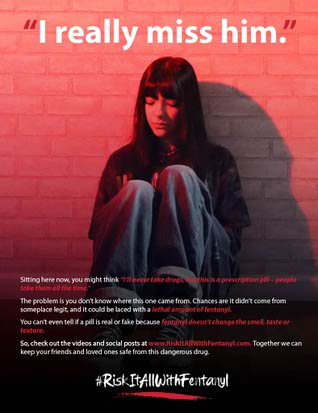
Courtesy of City of Henderson
Valentina Mandell, who lost her uncle to a fentanyl overdose, is pictured on a poster that’s part of the city of Henderson’s campaign focused on combating fentanyl overdoses in children.
Wednesday, May 17, 2023 | 2 a.m.
Fentanyl in Southern Nevada
Sixteen-year-old Valentina Mandell was on the way to Disneyland with her family two years ago when she learned her uncle — the man who helped bring sobriety to her father — had died from a fentanyl overdose.
“I instantly broke down,” Mandell said. “I promised I’d never do that and I would talk to my friends about the dangers.”
Mandell is among several teens spotlighted in a city of Henderson campaign focused on combating fentanyl overdoses in children.
The Southern Nevada Health District reports that 1,412 people have died in the region from opioid overdoses between January 2018 and July 2022. About 46%, or 653 of those deaths, involved fentanyl.
Metro Police reported eight child deaths from fentanyl in 2022, six in 2021, 10 in 2020 and one in 2019, according to data provided by the city of Henderson.
Nationwide, overdose deaths among 10- to 19-year-olds increased by 109% from 2019 to 2021, according to the Centers for Disease Control and Prevention.
Last week, Henderson launched the Risk it All with Fentanyl website (riskitallwithfentanyl.com), which provides fact sheets, resources, personal stories and videos that can be shared on social media.
Lisa Corrado, Henderson’s director of community development and services, said most fentanyl campaigns targeted adults.
“We haven’t been talking directly to kids,” Corrado said.
The campaign is aimed at warning children about the risks of taking prescription pills that aren’t prescribed to them, many of which are counterfeits.
“Six out of 10 counterfeit pills are laced with fentanyl,” Corrado said, citing a 2022 study from the U.S. Drug Enforcement Administration. “We want to raise awareness about fake pills and make them think twice.”
Fentanyl is 50 times stronger than heroin and 100 times stronger than morphine. A dose the size of five to seven grains of salt can cause death.
Mandell is featured in one of six videos released as part of the campaign.
The video, featuring dramatic music and lighting, shows Mandell sitting on a red couch as she talks about her uncle, Angelo Mandell, who died in 2021.
“I keep thinking that he’s actually alive and I will hear from him soon,” she says in the video.
A picture of Valentina Mandell with her uncle flashes on the screen. She holds a big bag of popcorn as her younger brother holds candy and while her uncle rests his arms across both of their shoulders. The trio is smiling in a lobby of a movie theater.
Guiseppe Mandell, Valentina’s father, said he beat an opioid addiction, partly, because of the help of his brother, Angelo.
Angelo finished treatment after receiving a DUI, his brother said.
As Angelo Mandell celebrated sobriety and worked to help others find theirs, Guiseppe Mandell said, he found himself falling into addiction and, at times, faced homelessness.
It started with opioids prescribed after a snowboarding injury in high school, Guiseppe Mandell said. It took a few years before an addiction really took hold, he said.
But with the help of his brother, he also found sobriety, he said.
Then in 2020, Angelo Mandell started to slip. He started smoking weed here and there and drinking a little, Guiseppe Mandell said.
One night in 2021, he did a line of cocaine at a bar with friends, he said. It was laced with fentanyl, he said.
“It was just a trace amount found in his system,” he said. “I would be lying if I didn’t feel guilty or have survivor’s remorse. He was the good one. He did all the right things.”
Dr. Timothy Jeider, a psychiatrist who works with children, said teens and pre-teens often “think they know everything, and they do generally feel untouchable.”
“Risk-taking is at its height and they don’t think it can happen to them,” he said, referring to harmful outcomes from dangerous behavior.
The power of fentanyl mixed with its accessibility and the risk-taking mindset of teens is like “throwing a match on gasoline,” he said.
The best things parents can do is have an open dialogue and be present with their children, Jeider said.
“If not a parent, someone else will be there,” Jeider said.
Parents who work long hours should find positive engagement for their teens through their church, school, family or neighbors, he said.
Teens also need validating conversations where they feel they are being heard, Jeider said.
For example, a child might tell a parent someone offered them drugs and the parent’s immediate response is anger, Jeider said.
A better response, he said, might be, “Hey, you had a friend offer you drugs. That must have been tough.”
Jeider said that kind of response makes the child feel heard but also doesn’t encourage poor decision making.
